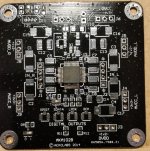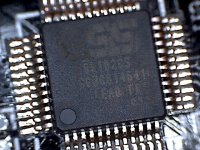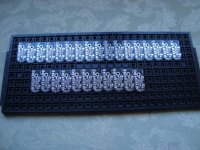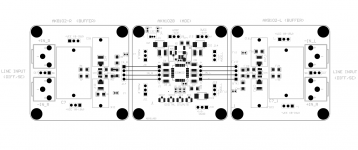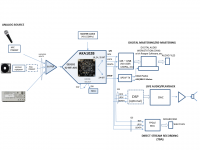yoohoo acko ... thanks for the fish ...
Shipping all the rest by this Friday!
Just arrived in the post today ...
... thank you, Acko !!!
Your are welcome. Enjoy the build!
Next up: set of regulator modules. Please review and finalise your selection for this GB:
Preview AKR75 3.3V 3-Term regulator.
Priced at USD 35 but those who are getting the ADC module will get discounted offer at USD 25 for use with AKA102B only and can be shipped together (fully assembled and tested). You will need one for each AVCC section but has sufficient drive if you wish to use only one AKR75 and share power with both the L/R channels. Also suitable for the oscillator section. Optimized and efficient design. Thermal paths on ground plane itself - No bulky heatsinks required for use with AKA102B or other low power loads
Also suitable for your other projects.
Separate GB now open here:
AKR75 GB
Attachments
Hello Acko and everyone,
What a nice looking project ! May I ask a couple questions ?
Judging from the board picture, it looks that the differential inputs goes straight into the ADC, with just a (filtering ?) capacitor in between.
I don't have a big experience in this matter but I have studied quite seriously the datasheet of an other manufacturer ADC, ARDA Tech not to name it, and there a buffer at the input, referenced to the 'BUFREF" output of the ADC so the incoming signal never goes over 23dBu.
In regard of the NDA you signed with ESS (I asked them for the datasheet but got no answer...yet), can you tell us if the ES9102 require a buffered, referenced input or am I missing something ?
Second question if you may : the converter can be referenced to an on-board crystal oscillator (there is a footprint for a Crystek one for instance). It also posses an MCK input, to solder what looks like a µFl connector.
Is this the input for a Wordclock signal that replace the on-board oscillator ?
It's been some time that I keep an eye on the ES9102 (that was canceled for a moment). I believe most people of the diyaudio forum will use it for digitizing their analog sources, be it a vinyl or a tape machine. I'm a sound engineer so I'm interested by the pro audio application of the chip. I definitely want to give a try to your board !
Thanks in advance,
Stéphane.
What a nice looking project ! May I ask a couple questions ?
Judging from the board picture, it looks that the differential inputs goes straight into the ADC, with just a (filtering ?) capacitor in between.
I don't have a big experience in this matter but I have studied quite seriously the datasheet of an other manufacturer ADC, ARDA Tech not to name it, and there a buffer at the input, referenced to the 'BUFREF" output of the ADC so the incoming signal never goes over 23dBu.
In regard of the NDA you signed with ESS (I asked them for the datasheet but got no answer...yet), can you tell us if the ES9102 require a buffered, referenced input or am I missing something ?
Second question if you may : the converter can be referenced to an on-board crystal oscillator (there is a footprint for a Crystek one for instance). It also posses an MCK input, to solder what looks like a µFl connector.
Is this the input for a Wordclock signal that replace the on-board oscillator ?
It's been some time that I keep an eye on the ES9102 (that was canceled for a moment). I believe most people of the diyaudio forum will use it for digitizing their analog sources, be it a vinyl or a tape machine. I'm a sound engineer so I'm interested by the pro audio application of the chip. I definitely want to give a try to your board !
Thanks in advance,
Stéphane.
"Separate GB now open here:
AKR75 GB"
Acko, do I have to do anything more at this stage to get my reserved LDOs?
//
AKR75 GB"
Acko, do I have to do anything more at this stage to get my reserved LDOs?
//
Hello Acko and everyone,
Judging from the board picture, it looks that the differential inputs goes straight into the ADC, with just a (filtering ?) capacitor in between.
I don't have a big experience in this matter but I have studied quite seriously the datasheet of an other manufacturer ADC, ARDA Tech not to name it, and there a buffer at the input, referenced to the 'BUFREF" output of the ADC so the incoming signal never goes over 23dBu.
In regard of the NDA you signed with ESS (I asked them for the datasheet but got no answer...yet), can you tell us if the ES9102 require a buffered, referenced input or am I missing something ?
BUFFER is required and will be available as a separate module (PN:AKB102)-TBA see pic:
Second question if you may : the converter can be referenced to an on-board crystal oscillator (there is a footprint for a Crystek one for instance). It also posses an MCK input, to solder what looks like a µFl connector.
Is this the input for a Wordclock signal that replace the on-board oscillator ?
Factory supplied with on-board oscillator (NDK type) but options to mount other types or connect external one via the UFL connector (goes to MCK directly, not WordClock)
Attachments
Last edited:
"Separate GB now open here:
AKR75 GB"
Acko, do I have to do anything more at this stage to get my reserved LDOs?
//
Please wait for a while... I am checking to see if there are sufficient parts for all the requests and then I will PM the ordering information.
Hi Acko,
I've added my self in the GB for 4x the 3.3V and 3x the 1.2V regulators. When do you think those buffers and eventual power regulators are known/ready ?
Roughly about like X-Mas or this month or .... ?
Thanks
I've added my self in the GB for 4x the 3.3V and 3x the 1.2V regulators. When do you think those buffers and eventual power regulators are known/ready ?
Roughly about like X-Mas or this month or .... ?
Thanks
Regulators will be ready in ~2-3wks as advised
As for the Buffer, I still need a bit of time to sort the layout of the board and then will advise pricing and lead times. Concept reference as shown in the users manual as a guide
As for the Buffer, I still need a bit of time to sort the layout of the board and then will advise pricing and lead times. Concept reference as shown in the users manual as a guide
Hi Acko,
what's in the pipe line from your side ?
I know the buffer is coming shortly, but I'm rather interrested in what's happening on the I2S side. The existing I2S->USB converters are not up to the S/R and bit rate of the ADC, furthermore is that FPGA/MCU block at the bottom up to the S/R and 32 bit stuff ?
Are you planning on something in that area and if so (I recon yes, since you mentioned TBA) do you have any idea of an ETA ?
I'm way over my head concerning the FPGA thingy, I stopped freaking out with ORs, ANDs, NORs, NANDs, EXORs, FFs, Shift registers, Latches, etc. when you had to buy them seperately (74xx, 4xxx series), so I probably can not be of any assistance there. I'll probably end up with discrete components the digital way...
what's in the pipe line from your side ?
I know the buffer is coming shortly, but I'm rather interrested in what's happening on the I2S side. The existing I2S->USB converters are not up to the S/R and bit rate of the ADC, furthermore is that FPGA/MCU block at the bottom up to the S/R and 32 bit stuff ?
Are you planning on something in that area and if so (I recon yes, since you mentioned TBA) do you have any idea of an ETA ?
I'm way over my head concerning the FPGA thingy, I stopped freaking out with ORs, ANDs, NORs, NANDs, EXORs, FFs, Shift registers, Latches, etc. when you had to buy them seperately (74xx, 4xxx series), so I probably can not be of any assistance there. I'll probably end up with discrete components the digital way...
Samples for tests in ~2wks.Hi Acko,
....
I know the buffer is coming shortly,
USBPAL can do 32bit, 384KHz and has good drivers that can be used with the DAW system so I would recommend this.The existing I2S->USB converters are not up to the S/R and bit rate of the ADC,
furthermore is that FPGA/MCU block at the bottom up to the S/R and 32 bit stuff ?
Are you planning on something in that area and if so (I recon yes, since you mentioned TBA) do you have any idea of an ETA ?
I'm way over my head concerning the FPGA thingy, I stopped freaking out with ORs, ANDs, NORs, NANDs, EXORs, FFs, Shift registers, Latches, etc. when you had to buy them seperately (74xx, 4xxx series), so I probably can not be of any assistance there. I'll probably end up with discrete components the digital way...
It is not so much on the gate logic or processing power but more on resources. Writing to SDdisk is relatively slow and therefore we need a deep FIFO to first buffer the incoming stream. This then needs to be dumped onto a bulk RAM. At 32bit/384KHz we are looking at 3MB/s of data and for a typical 3min recording will consume over 550MB of RAM. Once nicely captured this way even a simple 8-bit MCU can write at leisure to a disk - great for a portable system. I haven't seen anything off-the-shelf yet with this capacity and getting an FPGA specialist to do this professionally costs >$20K! Perhaps someone in the Community can come up with an implementation at affordable prices.
So going through the USB route is much more cost effective as the host PC resources can be used in the same way as above.
Last edited:
....
USBPAL can do 32bit, 384KHz and has good drivers that can be used with the DAW system so I would recommend this.
....
Sorry, a closer look at the specs indicate 24bit max only ... Maybe they can do 32 bit upon request.
Sorry, a closer look at the specs indicate 24bit max only ... Maybe they can do 32 bit upon request.
Hi Acko,
... I've got a USBPAL and on my computer with USBPAL's software it does 4 channels recording and playback simultaneously at 384 kHz/32 bits. With the right computer the USBPAL/software is very, very stable even over periods of e.g. 24 hours. No drop-outs in data transfers are the norm (I use a Dell E6420 (quiet) with a Samsung SSD HD and 8 GB RAM, although a 2.1 GHz I3 processor). However, with a previous Sony Vaio laptop which should be quite fast there were frequent drop-outs in the data transfer. I spoke with rigisystems' USBPAL designer about this and apparently it was one of the Sony's drivers that caused the trouble. He BTW recommends Intel processors and as I wrote even with a rather slow processor and an SSD HD I have observed no drop outs in my tests.
Additionally two USBPALs can be daisy-chained to allow for 8 channels at 384 kHz/32 bits (actually three USBPALs but apparently not that stable). This information is available on Rigisystems' website:
http://www.rigisystems.net/index.php/usb-audio-development-kit.html (multiple devices)
Cheers,
Jesper
Last edited:
Hi Acko,
... I've got a USBPAL and on my computer with USBPAL's software it does 4
Jesper
Hi Jesper,
I spoke to Rigisystems last year about USBPAL and was told that the drivers 'beep' periodically unless you invest in the SDK.
Any 'beeping' on your system ?
Hi Jesper,
I spoke to Rigisystems last year about USBPAL and was told that the drivers 'beep' periodically unless you invest in the SDK.
Any 'beeping' on your system ?
Hi ... I don't know actually. I haven't yet got around to test the USBPAL with an AD or DA - what I've done is to test how it streams data and with the setup described in the above post there now are no drop-outs in the datastream even over longer periods of time. However, what you mention is unknown to me ... I communicated quite extensively with the designer of the USBPAL and he never mentioned anything like this and was well aware that I would not be investing in the SDK (I'm not a programmer). Could be tested rather simply I guess by just having a recording software record from the USBPAL without an AD or DA connected and see if something like a beep happens ... Will try it out.
Regards,
Jesper
- Status
- Not open for further replies.
- Home
- Source & Line
- Digital Line Level
- ADC using ES9102/9112
